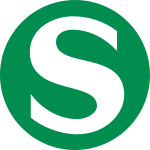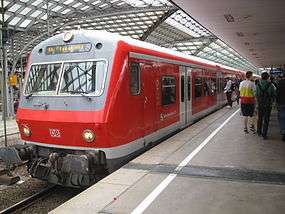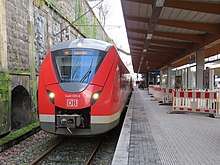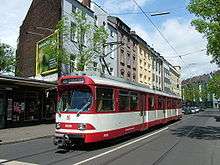Rhine-Ruhr S-Bahn
The Rhine-Ruhr S-Bahn (German: S-Bahn Rhein-Ruhr) is a polycentric and electrically driven S-train network covering the Rhine-Ruhr Metropolitan Region in the German federal state of North Rhine-Westphalia. This includes most of the Ruhr (and cities such as Dortmund, Duisburg and Essen), the Berg cities of Wuppertal and Solingen and parts of the Rhineland (with cities such as Cologne and Düsseldorf). The easternmost city within the S-Bahn Rhine-Ruhr network is Unna, the westernmost city served is Mönchengladbach.
 | |||
 X-Wagen coaches at Köln Hauptbahnhof | |||
| Overview | |||
|---|---|---|---|
| Locale | Rhine-Ruhr, North Rhine-Westphalia, Germany | ||
| Transit type | S-train | ||
| Number of lines | 16 | ||
| Number of stations | 124 | ||
| Annual ridership | 130 million Düsseldorf/Rhine-Ruhr: 98 million[1] Cologne: 32 million[2] | ||
| Headquarters | Düsseldorf, Germany | ||
| Website | www.s-bahn-rhein-ruhr.de www.s-bahn-koeln.de | ||
| Operation | |||
| Began operation | 1967 | ||
| Operator(s) | |||
| Headway | 20 min. | ||
| Technical | |||
| System length | 676 km (420.05 mi) | ||
| |||
The S-Bahn operates in the areas of the Verkehrsverbund Rhein-Ruhr (VRR) and Verkehrsverbund Rhein-Sieg (VRS) tariff associations, touching areas of the Aachener Verkehrsverbund (AVV) at Düren and Westfalentarif at Unna. The network was established in 1967 with a line connecting Ratingen Ost to Düsseldorf-Garath.
The system consists of 16 lines. Most of them are operated by DB Regio NRW, while line S28 is operated by Regiobahn and S7 by Abellio Rail NRW. The S19 will run 24/7 between Duren and Hennef for 17 stations and not only between Cologne Hbf and Cologne/Bonn Airport.
Rolling stock history
Age of steam
The predecessor of the S-Bahn was the so-called Bezirksschnellverkehr between the cities of Düsseldorf and Essen, which consisted of steam-powered push-pull trains, mainly hauled by Class 78 and Class 65 engines.
Early electric years
The first S-Bahn lines were operated using Silberling cars and Class 141 locomotives. However these were not suited for operations on a rapid transit network and were soon replaced by Class 420 electric multiple units.
Originally designed for the Munich S-Bahn, the Class 420 was judged in the mid-1970s to be unsuitable for the network, mainly due to being uncomfortable and lacking a lavatory and not being walk-through, since one could travel rather long distances on the Rhine-Ruhr network.
The x-Wagen era
Constructing an improved version of the 420 with the tentative designation Class 422 was discussed, but in 1978 the Deutsche Bundesbahn commissioned a batch of coaches from Duewag and MBB. These lightweight and modern coaches were designated as x-Wagen ("x-car") after their classification code Bx. Among the design elements inherited from the recent LHB prototype carriages were the bogies with disc brakes and rubber airbag shock absorbers that also included automated level control, ensuring level boarding from S-Bahn platforms with a standard height of 96 cm regardless of varying passenger loading.
In late 1978, the first prototypes of 2nd class type Bx 794.0 cars and Bxf 796.0 control cars were handed over to DB, followed by split first/second class cars type ABx 791.0 in early 1979. The prototypes were successful, so from 1981 to 1994 several series were commissioned, with some going to the Nuremberg S-Bahn system.
.jpg)
The x-Wagen were mechanically coupled to form fixed sets of typically one ABx car, one or two Bx cars and one Bxf control car. This way a train offered seating for a total of 222 to 302 passengers and standing room for another 429 to 539 passengers. A few five-car sets ran on peak time services. All cars were of a walk-through design with mechanical doors at each end. Initially the ABx car ran on the loco end to keep passengers looking for a seat from disturbing first-class passengers. The orientation of trains was not predictable in practice however, so the ABx car was instead put in the middle of the train. In later years, when insufficient numbers of Bx cars were ready for service, some trains ran with two ABx cars.
Traction was provided by the Class 111 locomotives produced locally by Krupp in Essen. They had been designed for long-haul Intercity and limited-stop commuter train services with a maximum speed of 140 km/h and were not an ideal fit for rapid transit duty. After the German reunification, even before the old Deutsche Bundesbahn was merged with the Deutsche Reichsbahn of East Germany to form the new Deutsche Bahn AG, the Class 143 Reichsbahn engines replaced the Class 111 on the S-Bahn network, limiting the top speed on the network to 120 km/h but with better acceleration and noticeably less jolting.
Rolling stock today


The Cologne S-Bahn section went into full operation in 2002 in conjunction with the opening of the Cologne-Frankfurt high speed line. It runs with Class 423 EMUs on lines S11, S12 and S13/S19. Due to recent service improvements, there are insufficient numbers of Class 423 EMUs available, so Class 420 electric multiple units can be found on line S12.
Starting in 2008, 84 units of Class 422 were introduced in the Ruhr area section and around Düsseldorf, replacing the x-Wagen loco-hauled trains.
These newer classes of EMUs once again increased the maximum speed on the network to 140 km/h where permitted, which together with the better acceleration of the EMUs did reduce delays that had become entrenched in the latter years of x-Wagen operations.
The S28 is not operated by DB Regio NRW, but by Regiobahn, which uses Bombardier TALENT DMUs. The S7 uses Alstom Coradia LINT DMUs and is operated by Abellio Rail NRW.
New electric rolling stock for the S5 and S8 lines was introduced in December 2014 after having been tested on S68 since October 2014. These Alstom Coradia trains are operated by DB Regio NRW and offer on-board toilet facilities.
All trains of Rhine-Ruhr S-Bahn ran with the red DB livery except for the S7 and S28 trainsets which are painted in the colours of their respective operators.
Rolling stock after 2019
Starting in December 2019, there will be major changes in the Ruhr area section of the network: The standard service pattern will be altered from a 20-minute to a 30-minute or 15-minute headway. Services around Düsseldorf and Cologne will not be affected and remain on their 20-minute schedule.
Several services will no longer be operated by DB Regio NRW, but by Abellio Rail NRW.[3] Simultaneously, the livery of all trains will change to green and white to uphold a uniform appearance regardless of operator.[4]
Lines S2, S3 and S9 as well as several Regionalbahn lines that will complement or supplant S-Bahn services will use Stadler FLIRT 3 XL units. Upon eventual electrification, those are also going to run on line S28, sporting Regiobahn's red and white livery.
Lines
The region's lines were mainly built by three major private railway companies of the early industrial era: The Cologne-Minden Railway Company, the Bergisch-Märkische Railway Company and the Rhenish Railway Company. After nationalisation and in the post-WW2-era, more lines were built or altered to accommodate S-Bahn services.
A number of tunnel sections were added to extend the S-Bahn to new high-density housing estates (e. g. Cologne-Chorweiler), to suburbs that had historically been villages (e. g. Dortmund-Lütgendortmund station) or the Dortmund university founded in 1968.
Lines before December 2019
| Line | Route | Railways used | Length | Opening date of first section[5] | First section[5] |
|---|---|---|---|---|---|
| S 1 | Dortmund – Bochum – Essen – Mülheim (Ruhr) – Duisburg – Düsseldorf Airport – Düsseldorf – Hilden – Solingen | Dortmund–Duisburg, Duisburg–Düsseldorf, Düsseldorf–Solingen | 97 km | 26.05.1974 | Bochum – DU-Großenbaum |
| S 2 | Dortmund – Dortmund-Dorstfeld – Dortmund-Mengede – Herne – (Gelsenkirchen – (Oberhausen – Duisburg) or Essen) or Recklinghausen | Dortmund–Dortmund-Dorstfeld, Dortmund-Dorstfeld–Dortmund-Mengede, Dortmund-Mengede–Herne/Gelsenkirchen/Duisburg, and part of Gelsenkirchen–Essen or Herne–Recklinghausen | 58 / 42 / 33 km | 02.06.1991 | Dortmund – Duisburg |
| S 3 | Oberhausen – Mülheim (Ruhr) – Essen – Essen-Steele – Hattingen (Ruhr) Mitte | Oberhausen–Essen-Steele Ost, Essen-Steele Ost–Bochum-Dahlhausen, Bochum-Dahlhausen–Hattingen (Ruhr) Mitte | 33 km | 26.05.1974 | Oberhausen – Hattingen (Ruhr) |
| S 4 | Dortmund-Lütgendortmund – Dortmund–Dorstfeld – Unna-Königsborn – Unna | Dortmund-Lütgendortmund–Dortmund Süd, Dortmund Süd–Unna-Königsborn, Unna-Königsborn–Unna | 30 km | 03.06.1984 | DO-Germania – Unna |
| S 5 | Dortmund – Witten – Wetter (Ruhr) – Hagen (– Mönchengladbach Hbf; as S8, see below) | Dortmund–Hagen | 31 km | 29.05.1994 | Whole length |
| S 6 | Essen – Ratingen Ost – Düsseldorf – Langenfeld (Rheinl) – Cologne – Cologne-Nippes | Essen–Essen-Werden, Essen-Werden–Düsseldorf, Düsseldorf–Cologne, Cologne–Köln-Nippes | 78 km | 28.09.1967 | Ratingen Ost – D-Garath |
| S 7 | Wuppertal – Remscheid – Solingen | Wuppertal–Wuppertal-Oberbarmen, Wuppertal-Oberbarmen–Solingen | 41 km | 15.12.2013 | Whole length |
| S 8 | (As S5, see above; Dortmund Hbf –) Hagen – Wuppertal – Wuppertal-Vohwinkel – Düsseldorf – Neuss – Mönchengladbach | Hagen-Schwelm, Schwelm–Wuppertal, Wuppertal–Düsseldorf, Düsseldorf–Mönchengladbach | 82 km | 29.05.1988 | Whole length |
| S 9 | Haltern am See – Gladbeck West – Bottrop – Essen – Essen-Steele – Velbert-Langenberg – Wuppertal-Vohwinkel – Wuppertal | Haltern–Essen-Dellwig Ost, Essen-Dellwig Ost–Essen West, Essen West–Essen-Steele, Essen-Steele–Wuppertal-Vohwinkel, Wuppertal-Vohwinkel–Wuppertal | 90 km | 24.05.1998 | Haltern – Essen-Steele |
| S 11 | Düsseldorf Airport Terminal – Düsseldorf – Neuss – Cologne-Nippes – Cologne – Bergisch Gladbach | Düsseldorf Airport Terminal–Düsseldorf-Unterrath railway, Düsseldorf-Unterrath–Düsseldorf, Neuss–Cologne, Cologne–Köln-Mülheim, Cologne-Mülheim–Bergisch Gladbach | 74 km | 01.06.1975 | K-Chorweiler – Berg. Gladbach |
| S 12 | S-Bahn-Rhein-Sieg Düren – Horrem – Cologne – Troisdorf – Siegburg/Bonn – Au (Sieg) |
Düren–Cologne, Cologne–Au Sieg | 105 km | 02.06.1991 | Köln-Nippes – Au (Sieg) |
| S 13 | S-Bahn-Rhein-Sieg (One train a day to/ from Aachen – Düren –) Horrem – Cologne – Cologne/Bonn Airport – Troisdorf |
Aachen–Cologne, Cologne–Troisdorf incl. Cologne Airport loop | 45 km | 15.12.2002 | Düren – Cologne-Deutz |
| S 19 | S-Bahn-Rhein-Sieg Horrem – Köln Hansaring – Köln – Cologne/Bonn Airport – Troisdorf– Siegburg/Bonn – Hennef (Sieg) 6 pairs of services of the S 13 in the morning peak 11 pairs of services of the S 13 in the afternoon peak |
Horrem–Köln, Cologne–Hennef incl. Cologne Airport loop | 14.12.2014 | Whole route | |
| S 23 | S-Bahn-Rhein-Sieg Euskirchen – Rheinbach – Meckenheim – Bonn Some trains continue from Euskirchen as RB 23 to Bad Münstereifel; all RB 23 services depart from Euskirchen as S 23 to Bonn Hbf |
Euskirchen–Bonn | 47 km | 14.12.2014 | Whole route |
| S 28 | Mettmann Stadtwald – Düsseldorf – Neuss – Kaarster See | Mettmann Stadtwald–Düsseldorf, Düsseldorf–Neuss, Neuss–Kaarster See | 34 km | 26.09.1999 | Whole route |
| S 68 | Wuppertal-Vohwinkel – Düsseldorf – Langenfeld (Rheinl) | Wuppertal–Düsseldorf, Düsseldorf–Langenfeld | 39 km | 13.12.2009 | Whole length |
Kursbuchstrecken 450.x (x is equivalent to the number of the line), as of 13 December 2009.
Lines after December 2019
| Line | Route | Railways used | Length | Operating company | Opening date of first section[5] | First section[5] |
|---|---|---|---|---|---|---|
| S 1 | Dortmund – Bochum – Essen – Mülheim (Ruhr) – Duisburg – Düsseldorf Airport – Düsseldorf – Hilden – Solingen | Dortmund–Duisburg, Duisburg–Düsseldorf, Düsseldorf–Solingen | 97 km | DB Regio | 26.05.1974 | Bochum – DU-Großenbaum |
| S 2 | Dortmund – Dortmund-Dorstfeld – Dortmund-Mengede – Herne
– (Gelsenkirchen – Essen) or |
Dortmund–Dortmund-Dorstfeld, Dortmund-Dorstfeld–Dortmund-Mengede, Dortmund-Mengede–Herne/Gelsenkirchen/Duisburg, and part of Gelsenkirchen–Essen or Herne–Recklinghausen | 58 / 42 / 33 km | Abellio | 02.06.1991 | Dortmund – Duisburg |
| S 3 | Oberhausen – Mülheim (Ruhr) – Essen – Essen-Steele – Hattingen (Ruhr) Mitte | Oberhausen–Essen-Steele Ost, Essen-Steele Ost–Bochum-Dahlhausen, Bochum-Dahlhausen–Hattingen (Ruhr) Mitte | 33 km | Abellio | 26.05.1974 | Oberhausen – Hattingen (Ruhr) |
| S 4 | Dortmund-Lütgendortmund – Dortmund–Dorstfeld – Unna-Königsborn – Unna | Dortmund-Lütgendortmund–Dortmund Süd, Dortmund Süd–Unna-Königsborn, Unna-Königsborn–Unna | 30 km | DB Regio | 03.06.1984 | DO-Germania – Unna |
| S 5 | Dortmund – Witten – Wetter (Ruhr) – Hagen (– Mönchengladbach Hbf; as S8, see below) | Dortmund–Hagen | 31 km | DB Regio | 29.05.1994 | Whole length |
| S 6 | Essen – Ratingen Ost – Düsseldorf – Langenfeld (Rheinl) – Cologne – Cologne-Nippes | Essen–Essen-Werden, Essen-Werden–Düsseldorf, Düsseldorf–Cologne, Cologne–Köln-Nippes | 78 km | DB Regio | 28.09.1967 | Ratingen Ost – D-Garath |
| S 7 | Wuppertal – Remscheid – Solingen | Wuppertal–Wuppertal-Oberbarmen, Wuppertal-Oberbarmen–Solingen | 41 km | Abellio | 15.12.2013 | Whole length |
| S 8 | (As S5, see above; Dortmund Hbf –) Hagen – Wuppertal – Wuppertal-Vohwinkel – Düsseldorf – Neuss – Mönchengladbach | Hagen-Schwelm, Schwelm–Wuppertal, Wuppertal–Düsseldorf, Düsseldorf–Mönchengladbach | 82 km | DB Regio | 29.05.1988 | Whole length |
| S 9 | Haltern am See – Gladbeck West – Bottrop – Essen – Essen-Steele – Velbert-Langenberg – Wuppertal-Vohwinkel – Wuppertal | Haltern–Essen-Dellwig Ost, Essen-Dellwig Ost–Essen West, Essen West–Essen-Steele, Essen-Steele–Wuppertal-Vohwinkel, Wuppertal-Vohwinkel–Wuppertal | 90 km | Abellio | 24.05.1998 | Haltern – Essen-Steele |
| S 11 | Düsseldorf Airport Terminal – Düsseldorf – Neuss – Cologne-Nippes – Cologne – Bergisch Gladbach | Düsseldorf Airport Terminal–Düsseldorf-Unterrath railway, Düsseldorf-Unterrath–Düsseldorf, Neuss–Cologne, Cologne–Köln-Mülheim, Cologne-Mülheim–Bergisch Gladbach | 74 km | DB Regio | 01.06.1975 | K-Chorweiler – Berg. Gladbach |
| S 12 | S-Bahn-Rhein-Sieg Düren – Horrem – Cologne – Troisdorf – Siegburg/Bonn – Au (Sieg) |
Düren–Cologne, Cologne–Au Sieg | 105 km | DB Regio | 02.06.1991 | Köln-Nippes – Au (Sieg) |
| S 13 | S-Bahn-Rhein-Sieg (One train a day to/ from Aachen – Düren –) Horrem – Cologne – Cologne/Bonn Airport – Troisdorf |
Aachen–Cologne, Cologne–Troisdorf incl. Cologne Airport loop | 45 km | DB Regio | 15.12.2002 | Düren – Cologne-Deutz |
| S 19 | S-Bahn-Rhein-Sieg Horrem – Köln Hansaring – Köln – Cologne/Bonn Airport – Troisdorf– Siegburg/Bonn – Hennef (Sieg) 6 pairs of services of the S 13 in the morning peak 11 pairs of services of the S 13 in the afternoon peak |
Horrem–Köln, Cologne–Hennef incl. Cologne Airport loop | DB Regio | 14.12.2014 | Whole route | |
| S 23 | S-Bahn-Rhein-Sieg Euskirchen – Rheinbach – Meckenheim – Bonn Some trains continue from Euskirchen as RB 23 to Bad Münstereifel; all RB 23 services depart from Euskirchen as S 23 to Bonn Hbf |
Euskirchen–Bonn | 47 km | DB Regio | 14.12.2014 | Whole route |
| S 28 | Mettmann Stadtwald – Düsseldorf – Neuss – Kaarster See | Mettmann Stadtwald–Düsseldorf, Düsseldorf–Neuss, Neuss–Kaarster See | 34 km | Regiobahn | 26.09.1999 | Whole route |
| S 68 | Wuppertal-Vohwinkel – Düsseldorf – Langenfeld (Rheinl) | Wuppertal–Düsseldorf, Düsseldorf–Langenfeld | 39 km | DB Regio | 13.12.2009 | Whole length |
Network map

See also
- List of rapid transit systems
References
- Press note Deutsche Bahn, 28. January 2011
- Facts and figures Archived 2011-07-06 at the Wayback Machine S-Bahn Köln
- Koch, Hildegard Braun, Oliver (2016-07-07). "Deutsche Bahn verliert acht VRR-Linien im Ruhrgebiet" (in German). Retrieved 2017-01-28.
- "VRR: Heute S-Bahnvergabeentscheidung – BAHN[berufe]". www.bahnberufe.de (in German). Retrieved 2017-01-28.
- "S-Bahn Rhein-Ruhr-Sieg – Geschichte" (in German). www.indusi.de. Retrieved 25 August 2011.


